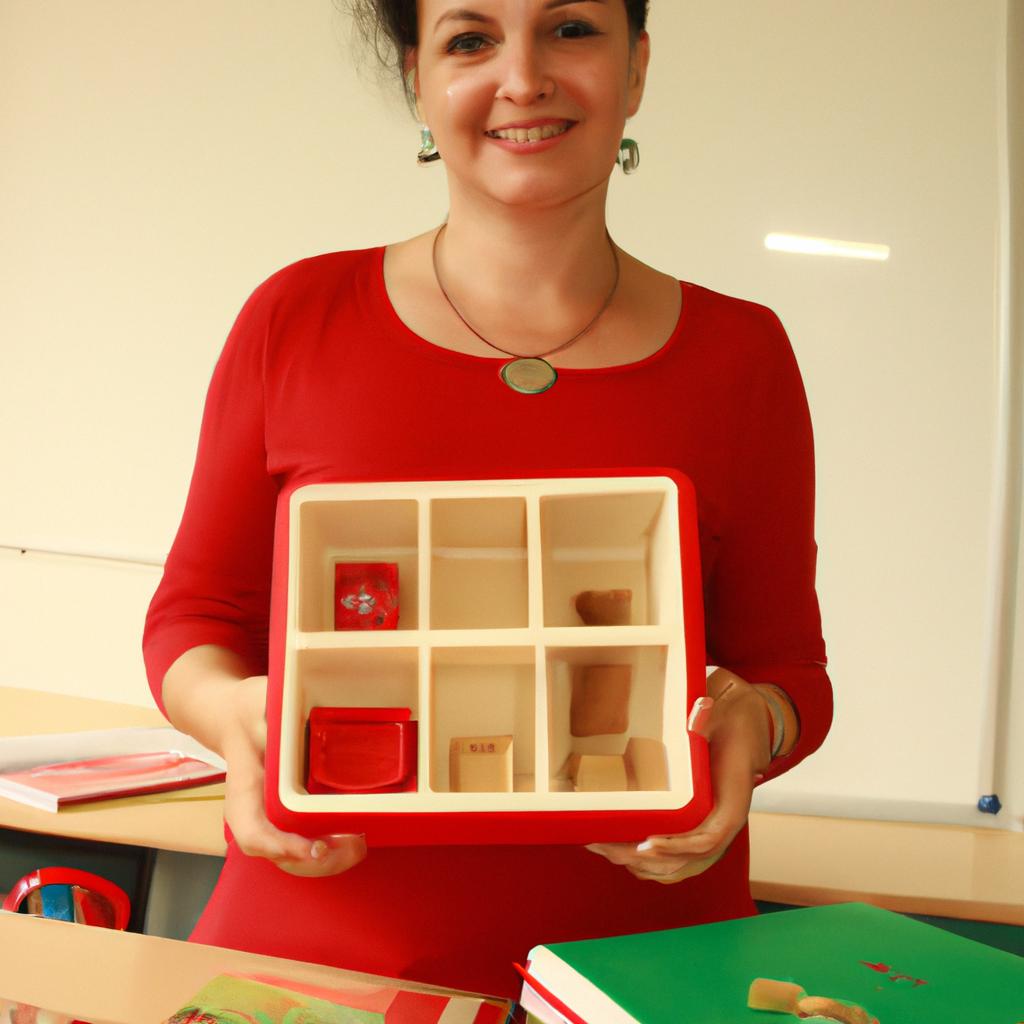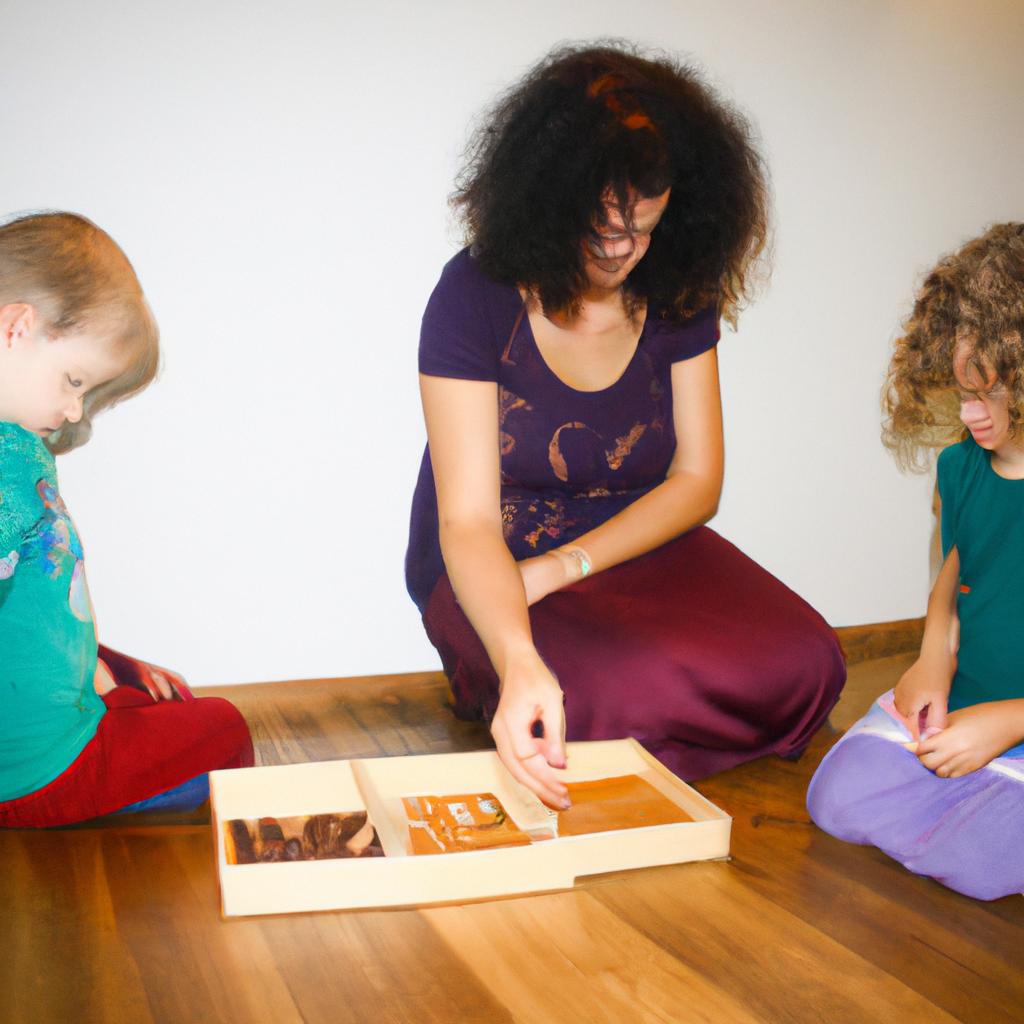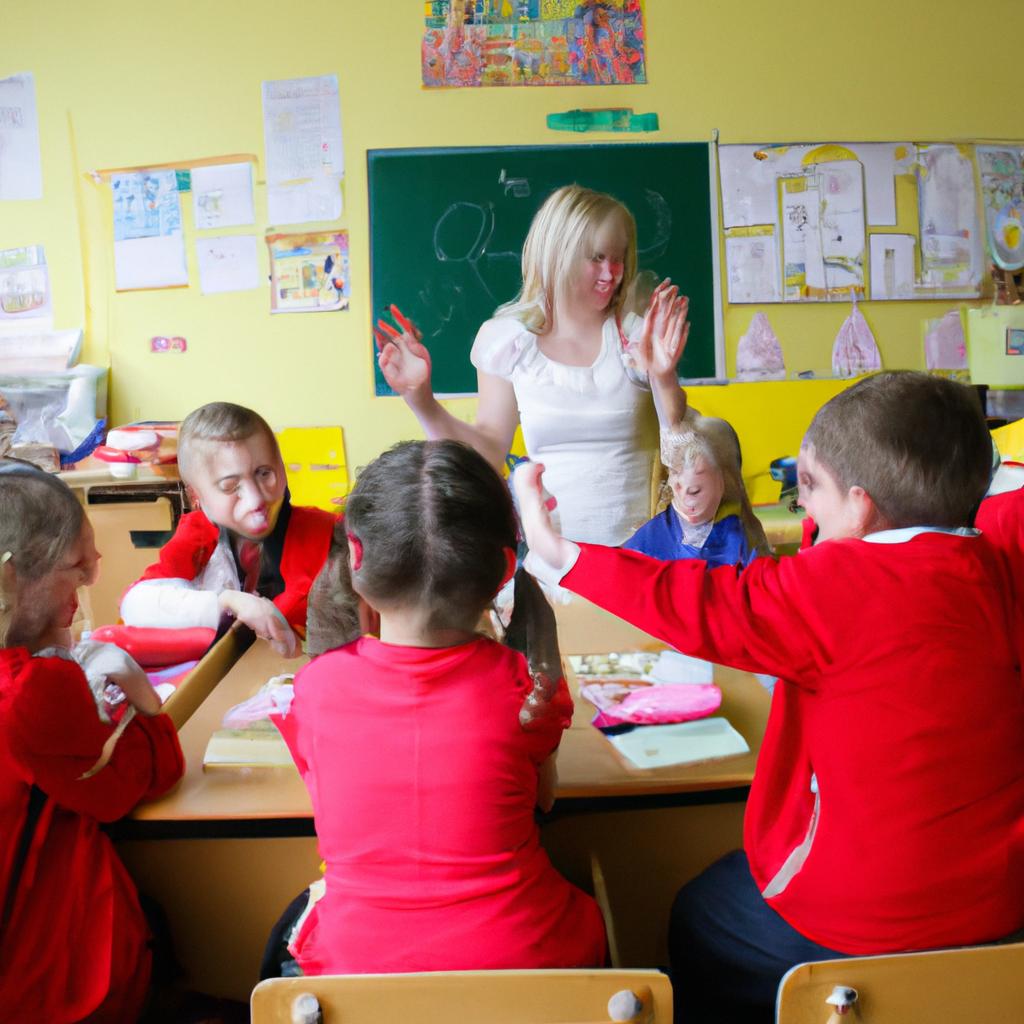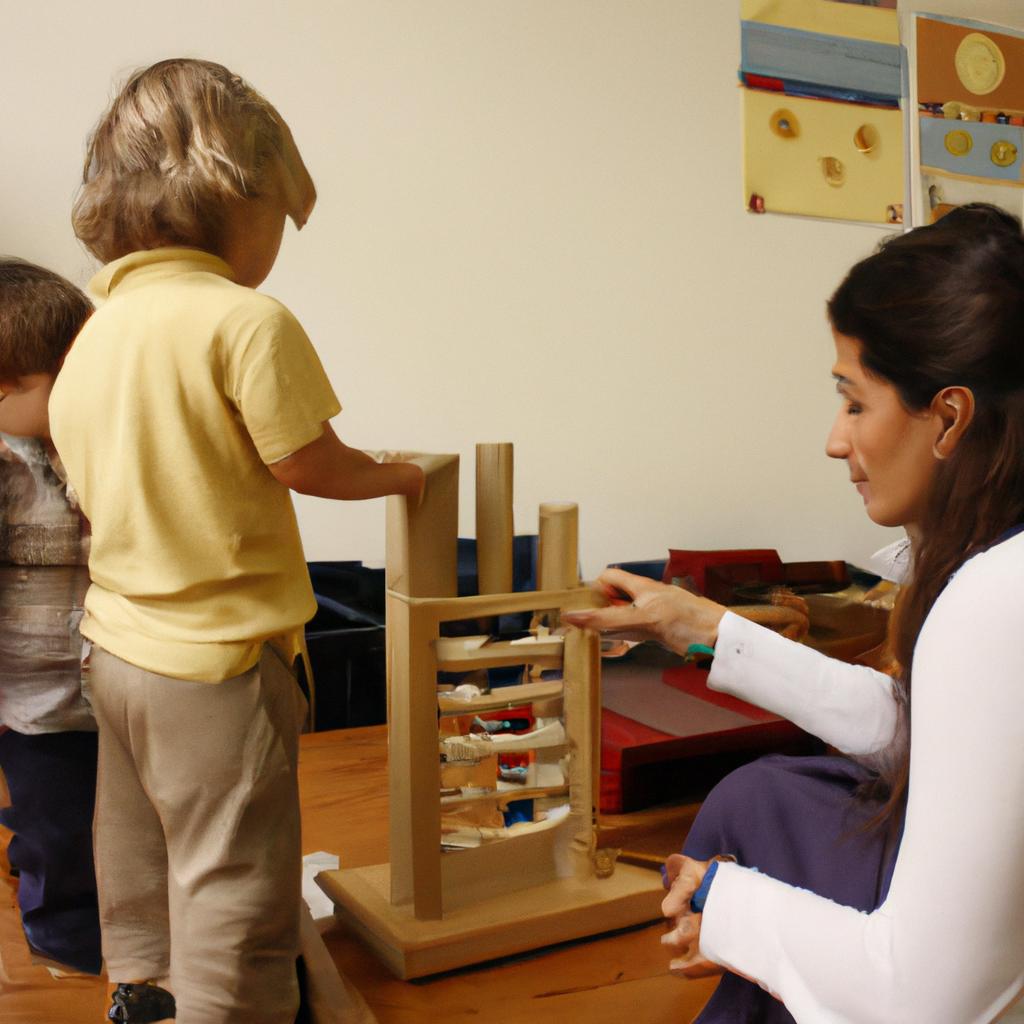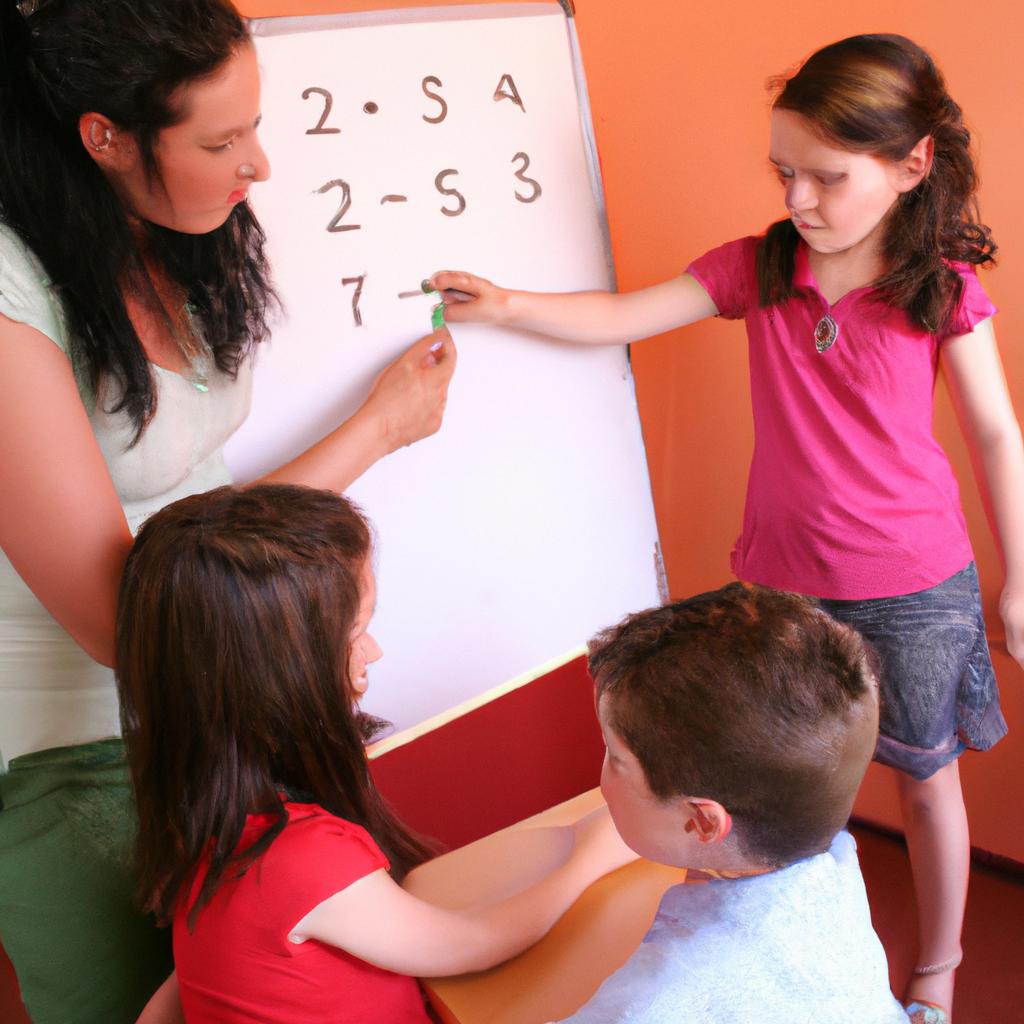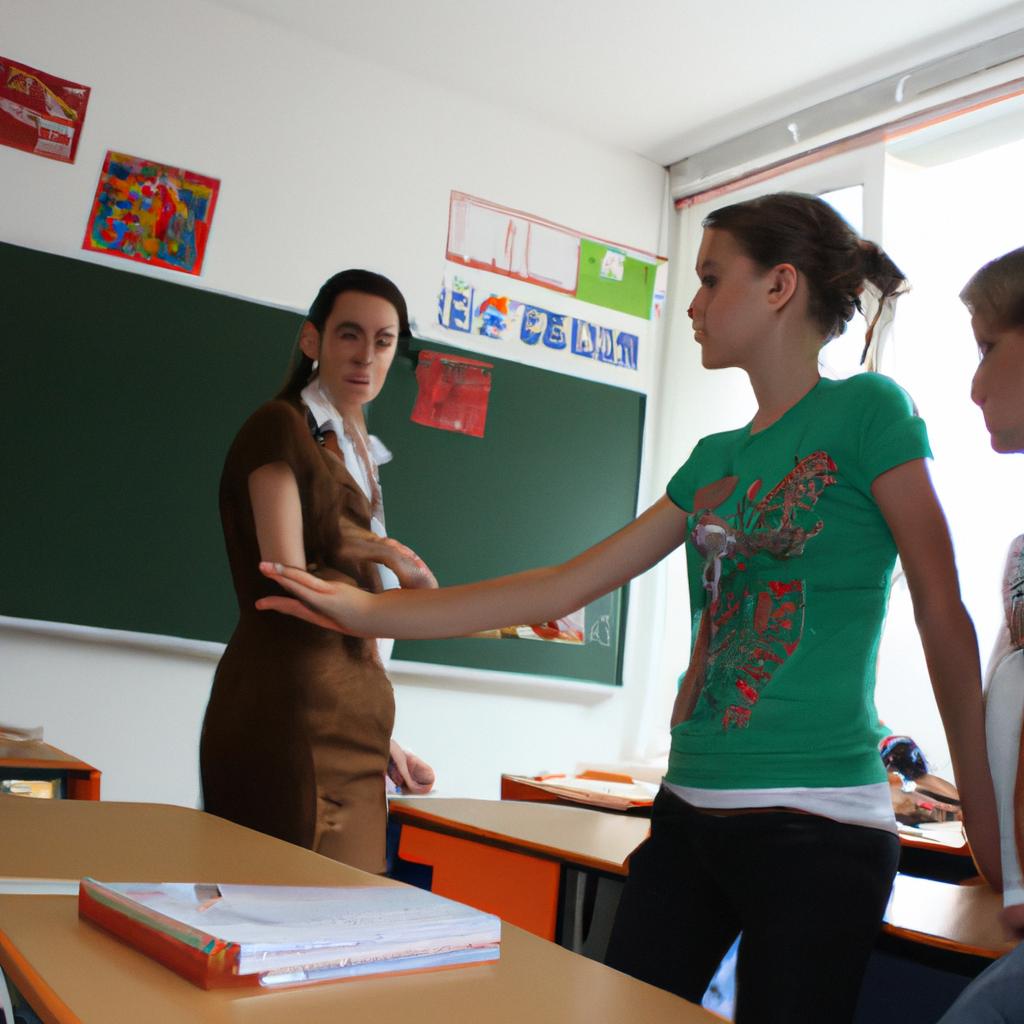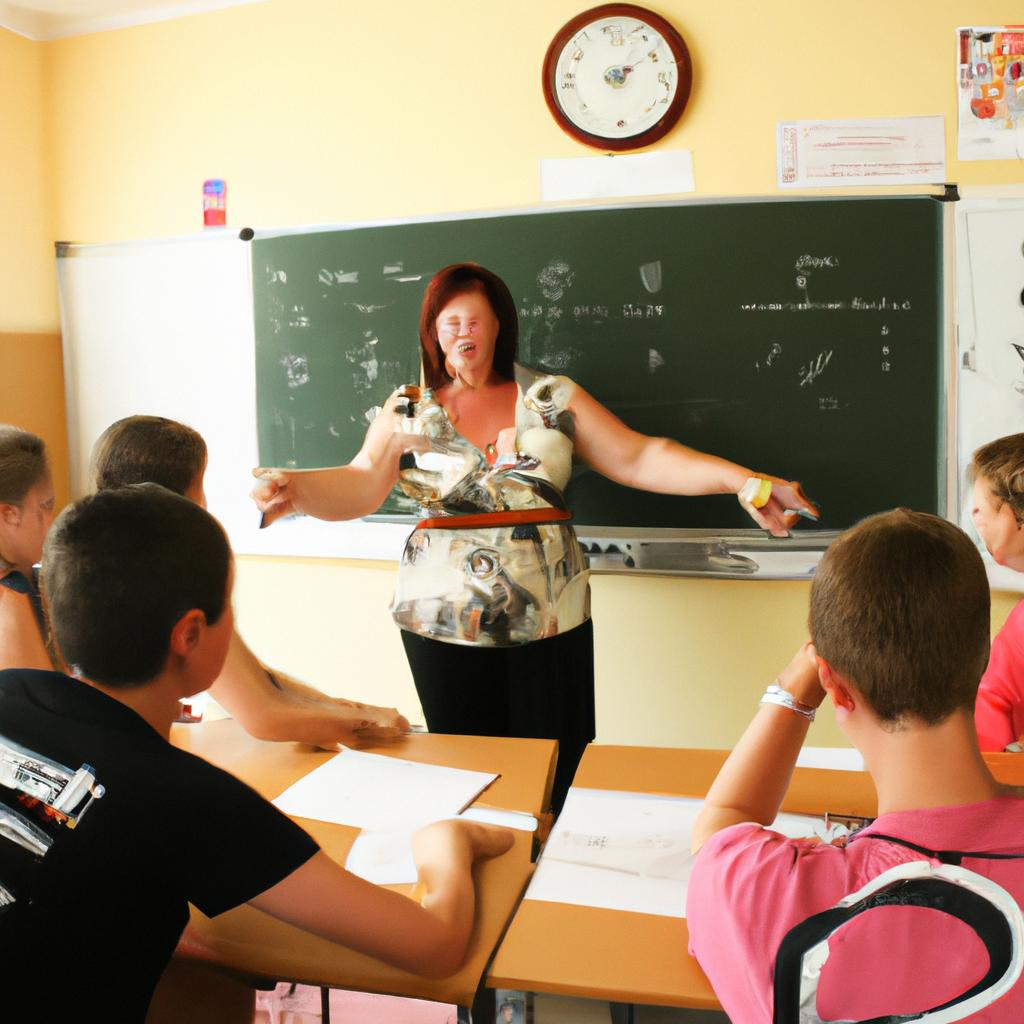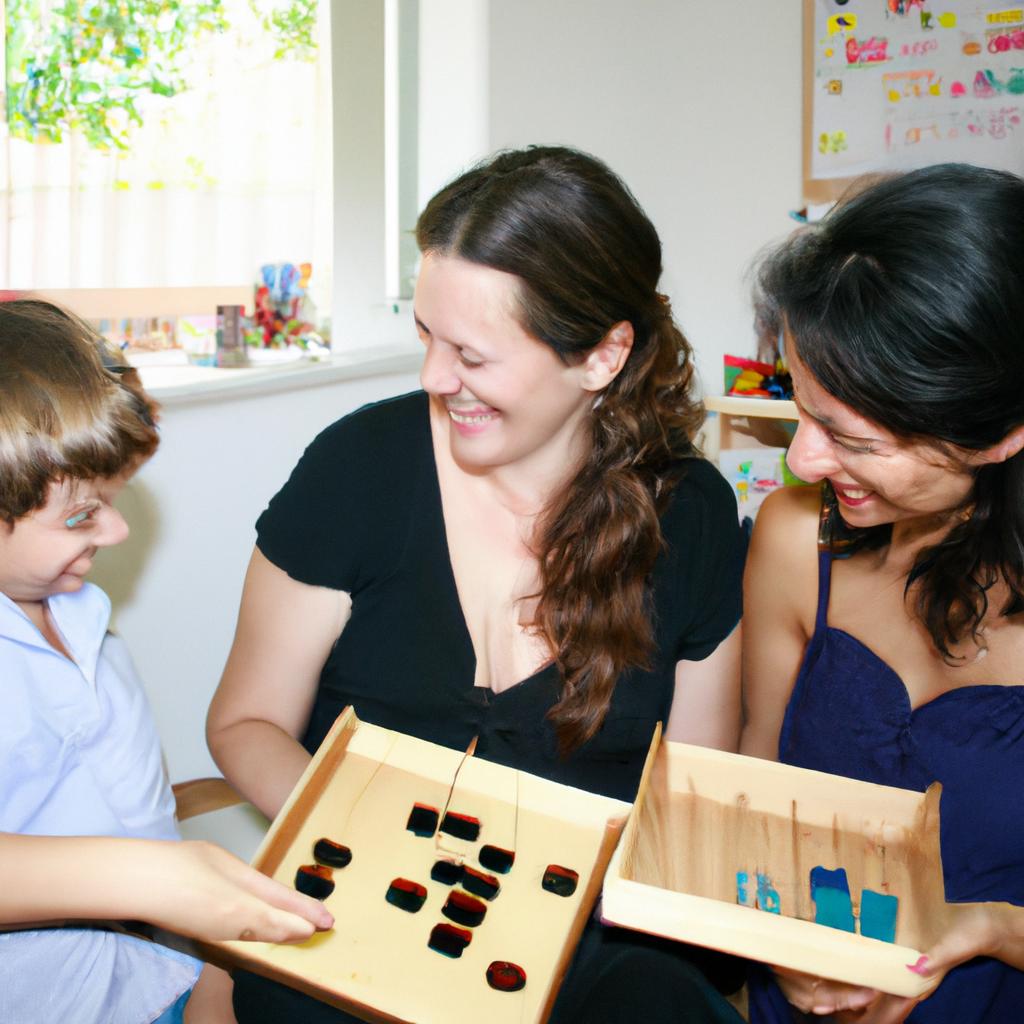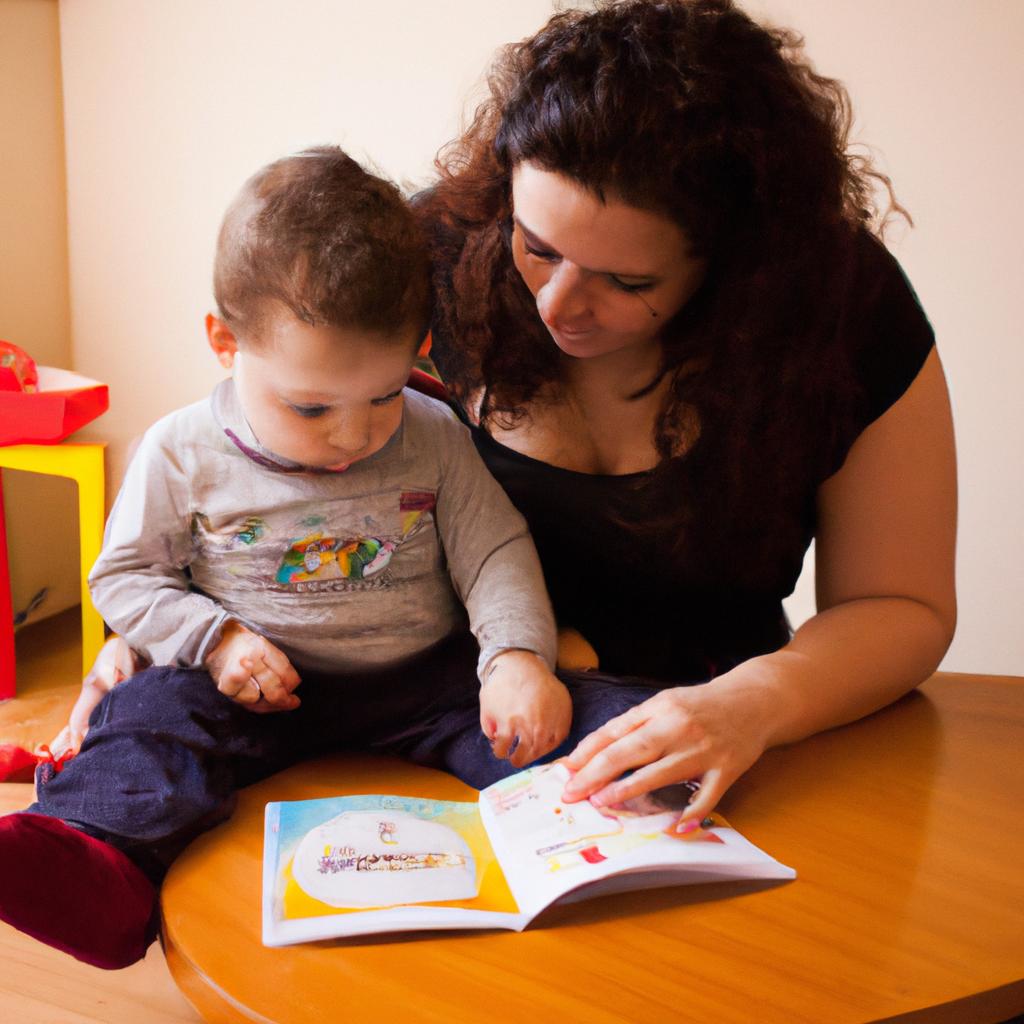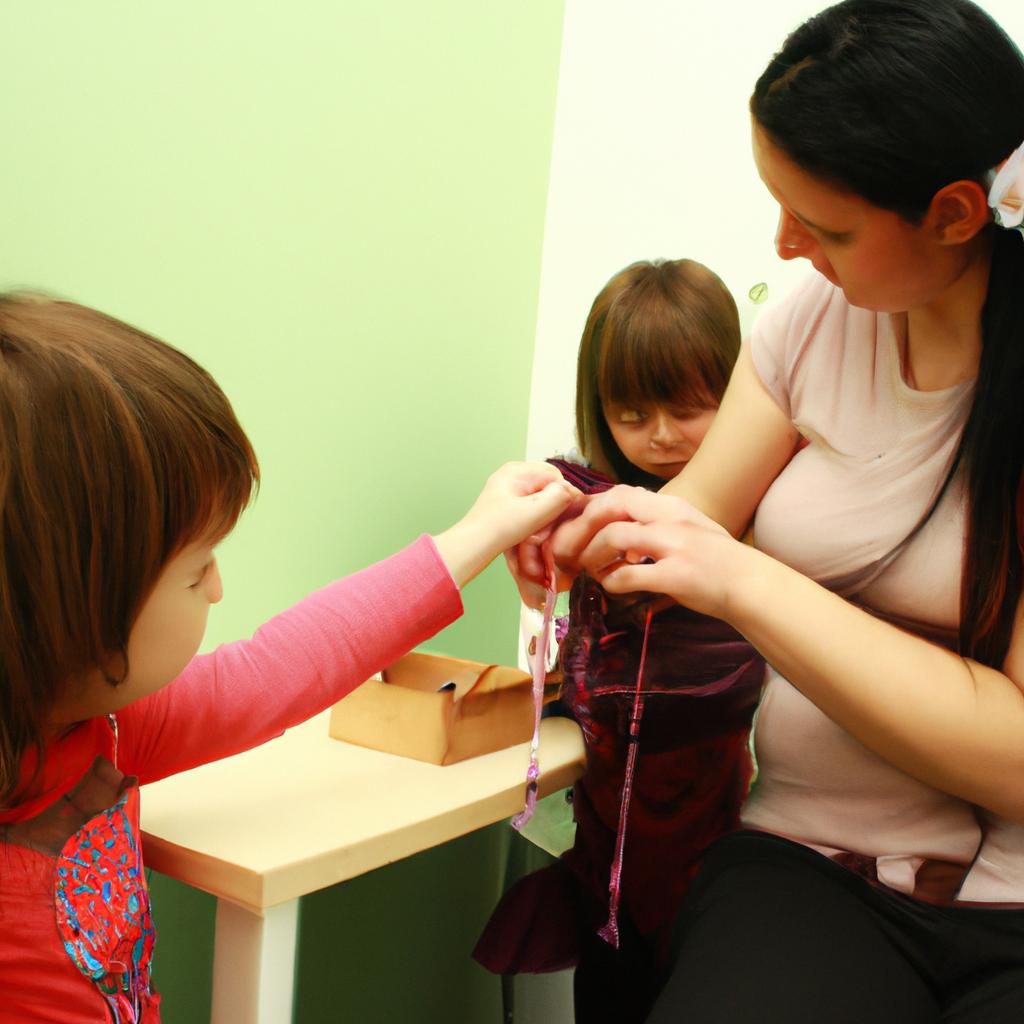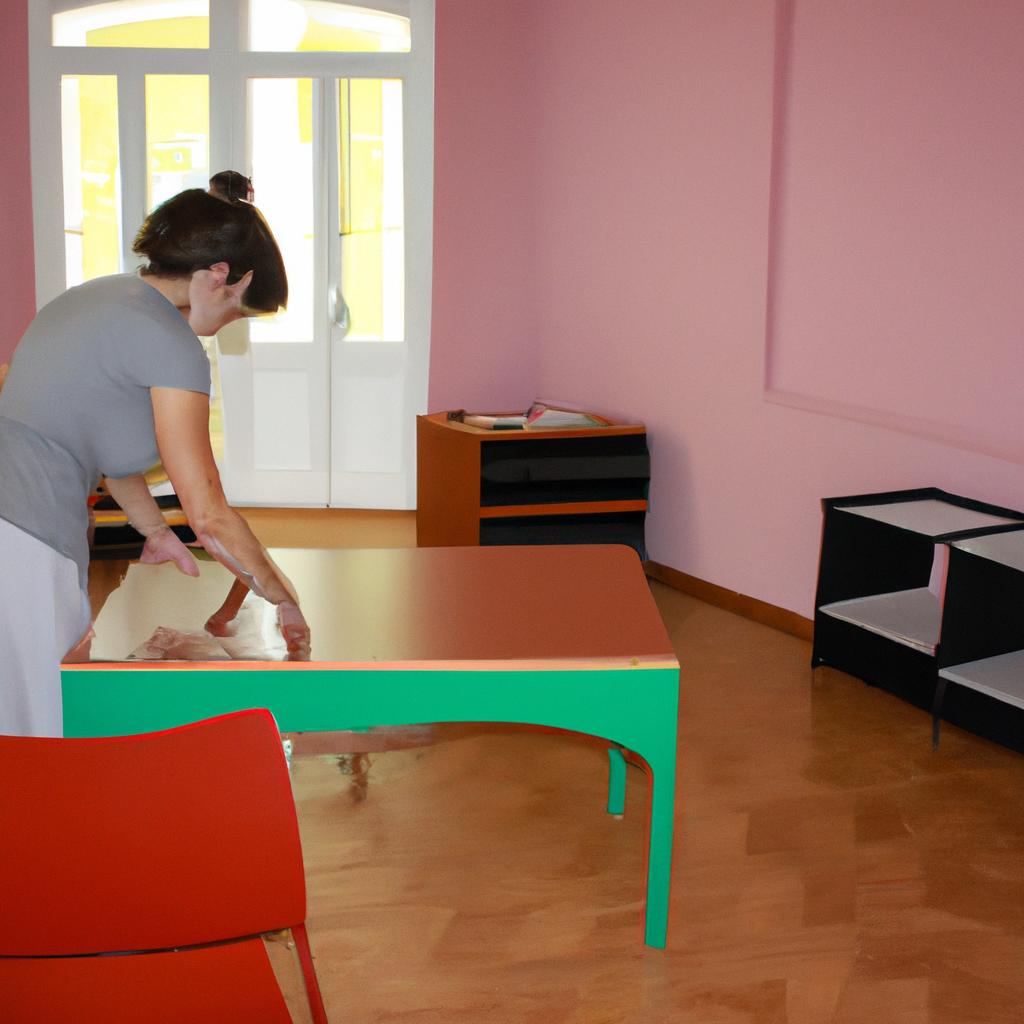Montessori education is a unique approach to learning that emphasizes hands-on experiences and self-directed exploration. At the core of this educational philosophy are Montessori materials, which play a crucial role in supporting children’s development across various domains. These carefully designed materials not only serve as tools for engaging with abstract concepts but also foster independence, concentration, and problem-solving skills. For instance, consider an imaginary scenario where a child named Sarah enters a Montessori classroom filled with enticing materials such as the pink tower or the bead stair. As she engages with these materials at her own pace and according to her interests, Sarah begins to develop fundamental math and spatial awareness skills without even realizing it.
In addition to its distinct set of materials, Montessori schools also follow a well-structured curriculum that aligns with Maria Montessori’s principles of education. The curriculum is designed to meet each child’s developmental needs by providing opportunities for holistic growth – socially, emotionally, intellectually, and physically. It encompasses a wide range of subjects including language arts, mathematics, science, geography, practical life skills, sensorial development, and cultural studies. Through this comprehensive curriculum, students acquire knowledge through their own active involvement rather than relying on traditional teacher-led instruction. This promotes critical thinking, problem-solving, and a deep understanding of concepts.
One of the key aspects of Montessori education is the emphasis on individualized learning. Each child is seen as a unique individual with their own strengths, interests, and learning styles. Montessori teachers observe and assess each student’s progress to tailor their instruction and provide appropriate challenges. This approach allows children to work at their own pace, building confidence and a love for learning.
Another important element in Montessori education is the prepared environment. Classrooms are carefully organized and equipped with materials that are easily accessible to students. The layout encourages independence and self-directed learning, as children can choose activities based on their interests and abilities. The materials are designed to be self-correcting, providing immediate feedback to students and promoting independent problem-solving skills.
Montessori education also places great importance on fostering a sense of community and social development. Mixed-age classrooms allow for peer collaboration and mentorship opportunities, where older children can guide younger ones. This creates a supportive and cooperative atmosphere where children learn from one another, practice empathy, develop emotional intelligence, resolve conflicts, and build strong relationships.
Overall, Montessori education aims to nurture the whole child – intellectually, emotionally, socially, and physically – by providing an engaging environment that supports natural curiosity, fosters independence and critical thinking skills while promoting a love for lifelong learning.
Philosophy of Montessori Education
Imagine a classroom where children are given the freedom to explore and learn at their own pace, guided by their innate curiosity. This is the essence of Montessori education, a pedagogical approach developed by Dr. Maria Montessori in the early 20th century. At its core, Montessori philosophy emphasizes respect for each child’s individuality, fostering independence, and cultivating a love for learning.
One key aspect of the Montessori method is the prepared environment, which is carefully designed to meet the developmental needs of children. In this environment, materials play a crucial role in facilitating independent exploration and self-directed learning. For instance, take the case of Sarah, a five-year-old student in a Montessori school. Through hands-on activities with specially designed materials like colorful geometric shapes and movable letters, Sarah gains an understanding of mathematical concepts and develops her language skills organically.
In order to fully grasp the significance of Montessori education, it is essential to understand its underlying principles:
- Child-centered approach: The focus is on meeting each child’s unique needs and interests.
- Self-correction: Materials are self-correcting, allowing children to identify errors independently without relying on external validation.
- Prepared environment: A thoughtfully arranged space that promotes engagement and encourages exploration.
- Mixed-age classrooms: Children learn from one another as they collaborate across age groups.
This table showcases some fundamental differences between traditional education and the Montessori approach:
| Traditional Education | Montessori Education |
|---|---|
| Teacher-led | Child-led |
| Rigid curriculum | Individualized |
| Passive learning | Active learning |
| Competitive | Cooperative |
By embracing these principles within a supportive educational setting, Montessori schools create an environment where children can develop not only academically but also emotionally and socially. As we delve deeper into the importance of sensorial development in Montessori, we will explore how this pedagogy nurtures and enhances children’s sensory experiences, paving the way for further cognitive growth.
Transitioning to the next section, let us now examine the significance of sensorial development in Montessori education.
Importance of Sensorial Development in Montessori
Building upon the philosophy of Montessori education, an essential aspect of this pedagogy focuses on the importance of sensorial development. By engaging children’s senses and allowing them to explore their environment through purposeful activities, Montessori schools foster holistic learning experiences that enhance cognitive, social-emotional, and physical development.
Paragraph 1:
For instance, in a Montessori classroom, you might observe a group of preschoolers immersed in a sensorial activity using geometric solids. These three-dimensional shapes not only provide visual stimulation but also allow children to touch and feel different surfaces while gaining an understanding of spatial relationships. Through such hands-on exploration, young learners develop their ability to identify similarities and differences among objects, thereby strengthening their perceptual skills.
Paragraph 2:
The significance of Sensorial Development in Montessori education is further underscored by its numerous benefits for children’s overall growth. Consider the following emotional responses that can be evoked:
- A sense of wonder: As children engage with various materials designed to stimulate their senses, they experience moments of awe and curiosity.
- Self-confidence: Mastering tasks involving sensory input boosts children’s self-esteem as they gain confidence in their abilities.
- Concentration: Focused engagement with the sensorial materials fosters concentration skills, enhancing attention spans over time.
- Developmental milestones: Sensorial activities aid in the refinement of fine motor skills necessary for everyday tasks like tying shoelaces or buttoning clothes.
To illustrate these points further, refer to the table below showcasing some commonly used sensorial materials alongside their corresponding developmental benefits:
| Sensorial Material | Developmental Benefits |
|---|---|
| Pink Tower | Visual discrimination |
| Sound Cylinders | Auditory perception |
| Color Tablets | Chromatic differentiation |
| Smelling Bottles | Olfactory awareness |
Paragraph 3:
By incorporating well-designed sensorial activities into the curriculum, Montessori schools provide children with a solid foundation for future learning and academic success. These experiences not only engage their senses but also promote critical thinking skills as they analyze, compare, and classify stimuli. As children progress through the Montessori program, this enhanced ability to perceive and interpret sensory information becomes an invaluable asset when exploring math concepts using Montessori materials.
Moving forward, let’s delve into how Montessori materials facilitate the exploration of various mathematical concepts in early childhood education
Exploring Math Concepts with Montessori Materials
Transitioning from the importance of sensorial development, it is evident that the Montessori method extends its focus to various aspects of early childhood education. One such crucial aspect is language development, which holds tremendous significance in a child’s overall cognitive and social-emotional growth. By employing a range of purposeful materials and activities, the Montessori curriculum fosters an environment conducive to enhancing language skills.
Consider a hypothetical scenario where a four-year-old named Emily enters a Montessori classroom with limited vocabulary and struggles to express herself effectively. Through carefully designed language materials and exercises, Emily engages in hands-on experiences that stimulate her interest in learning new words and refining her communication abilities. For instance, using the moveable alphabet, she can physically construct words by selecting appropriate letters, reinforcing letter-sound correspondence while developing phonemic awareness.
The Montessori approach emphasizes several key strategies for enhancing language skills:
- Multisensory Learning: Engaging multiple senses simultaneously aids in strengthening neural connections related to language processing.
- Individualized Instruction: Tailoring activities based on each child’s unique interests and needs promotes personalized learning experiences.
- Practical Life Connections: Integrating real-life scenarios into language lessons facilitates meaningful contextual understanding.
- Respectful Communication Environment: Encouraging open-ended conversations supports children in expressing their thoughts freely without fear of judgment or criticism.
To further illustrate these strategies, consider the following table showcasing examples of how they are implemented within a typical Montessori classroom setting:
| Strategy | Example Activity |
|---|---|
| Multisensory Learning | Using textured sandpaper letters during letter recognition |
| Individualized Instruction | Offering different reading levels tailored to each student |
| Practical Life Connections | Labeling objects around the classroom for vocabulary building |
| Respectful Communication | Conducting circle time discussions with turn-taking |
By incorporating these strategies and utilizing carefully selected materials, Montessori educators create an environment that nurtures language development effectively. As children engage in purposeful activities, they naturally develop vocabulary, phonics skills, and a love for reading and writing – all of which form a solid foundation for lifelong learning.
Transitioning smoothly to the subsequent section on “Enhancing Language Skills through Montessori Approach,” we delve further into specific approaches employed by Montessori schools to cultivate proficient communicators.
Enhancing Language Skills through Montessori Approach
In the previous section, we delved into how Montessori materials can be used to introduce and develop math concepts in young learners. Now, let’s further explore the various ways these materials facilitate a hands-on learning experience that enhances mathematical understanding.
Imagine a group of preschoolers engaging with Montessori math materials, such as the Number Rods. Each child is given a set of rods varying in length from one unit to ten units. Through exploration and manipulation, they begin to grasp fundamental math concepts like sequencing, comparisons, and addition. For instance, one child arranges the rods in ascending order and realizes that each rod represents a different number value. This discovery sparks curiosity and enthusiasm for further exploration.
The benefits of incorporating Montessori math materials extend beyond individual accomplishments. Here are some key advantages:
- Engagement: The tactile nature of Montessori materials captivates children’s attention and keeps them actively engaged in their learning process.
- Concrete Understanding: By using physical objects to represent abstract concepts, students develop a concrete understanding of mathematical principles before moving on to symbolic representation.
- Independent Learning: Montessori math materials empower children to work independently at their own pace while building confidence in problem-solving skills.
- Collaboration Opportunities: Group activities involving these materials encourage collaboration among peers, fostering social development alongside mathematical growth.
To better illustrate the impact of Montessori math materials, consider the following table showcasing notable improvements observed in children who have consistently used these resources:
| Improvement | Before Using Montessori Math Materials | After Using Montessori Math Materials |
|---|---|---|
| Conceptual Understanding | Limited grasp of basic arithmetic operations | Proficient knowledge and application of core math concepts |
| Confidence Levels | Lack self-assurance when approaching numerical tasks | Increased confidence leading to active participation |
| Problem-Solving Skills | Struggle with logical reasoning and analytical thinking | Improved ability to solve complex math problems |
| Motivation and Enthusiasm | Disinterested in math activities, often displaying reluctance | Positive attitude towards math, showing eagerness to explore new concepts |
By integrating Montessori materials into the curriculum, educators provide a solid foundation for mathematical development that fosters conceptual understanding, confidence, problem-solving skills, and motivation among young learners.
As we transition into the next section on “Enhancing Language Skills through the Montessori Approach,” let us reflect on how the incorporation of hands-on learning experiences with math materials can lay the groundwork for an enriched educational journey.
Introducing Cultural Diversity in Montessori Curriculum
By utilizing the Montessori approach, children are provided with a conducive learning environment that enhances their language skills. For instance, let’s consider the case of Sarah, a 4-year-old student at a Montessori school. Through various activities and materials, such as sandpaper letters and movable alphabets, Sarah is encouraged to explore and develop her phonetic awareness.
The Montessori method employs several strategies to foster language development effectively:
-
Multisensory Learning: The use of hands-on materials engages multiple senses simultaneously, promoting active participation in the learning process. This multisensory experience helps children associate sounds with symbols more easily.
-
Individualized Instruction: Each child progresses at their own pace while receiving personalized guidance from trained educators. This tailored approach allows students like Sarah to focus on specific areas where they may need additional support or challenge.
-
Integrated Curriculum: Language skills are integrated into every aspect of the curriculum rather than being taught in isolation. By incorporating reading, writing, speaking, and listening activities across different subject areas, children gain a holistic understanding of language.
-
Social Interaction: Collaborative activities encourage peer interaction and communication, which further enhance language skills. Group discussions, role-playing exercises, and storytelling sessions provide opportunities for children to express themselves verbally.
In addition to these strategies, it is crucial to create an inclusive environment that celebrates cultural diversity within the Montessori curriculum. Introducing Cultural Diversity in Montessori Curriculum
Principles Guiding Montessori Material Selection
Building upon the importance of cultural diversity in a Montessori curriculum, it is essential to explore strategies for incorporating this concept effectively. One hypothetical example that illustrates the significance of cultural diversity in a Montessori classroom involves a group of preschool-aged children from various ethnic backgrounds. By integrating culturally diverse materials and activities into their daily learning experiences, these children have the opportunity to develop an appreciation for different cultures while fostering empathy and respect.
To ensure the successful implementation of cultural diversity within the Montessori curriculum, educators can consider the following guidelines:
- Provide multicultural resources: Incorporating books, posters, puzzles, and other educational materials that represent different cultures allows children to learn about various traditions, languages, and customs.
- Celebrate cultural festivals: Organizing events or projects centered around significant cultural festivals such as Diwali, Hanukkah, or Chinese New Year creates opportunities for cross-cultural understanding and celebration.
- Encourage peer sharing: Promoting open discussions among students about their own cultural backgrounds encourages them to share personal experiences with their peers, fostering mutual understanding and acceptance.
- Foster inclusive language: Using inclusive language that acknowledges and respects all cultures helps create an environment where every child feels valued and included.
By employing these strategies consistently throughout the Montessori curriculum, educators facilitate an enriching experience for children by promoting cultural awareness and sensitivity. This approach not only expands their knowledge but also develops their social skills and promotes inclusivity.
Benefits of Sensorial Materials in Montessori Education
Principles Guiding Montessori Material Selection: A Case Study
To understand the principles guiding material selection in a Montessori school, let’s consider a hypothetical scenario. Imagine a group of children aged 3 to 6 years old in a Montessori classroom. One child, Emily, is particularly interested in developing her fine motor skills and concentration. The teacher observes that Emily enjoys activities that involve sorting objects by size and color.
The first principle guiding material selection in this case would be to offer materials that match the child’s developmental needs and interests. In response to Emily’s interest, the teacher provides her with the ‘Color Sorting’ material from the Sensorial area. This material consists of different colored tablets that can be sorted into separate compartments based on their hues. By engaging with this material, Emily not only hones her fine motor skills but also enhances her ability to discriminate colors.
Additionally, materials should promote independence and allow for self-correction. The ‘Color Sorting’ material aligns with this principle as it allows Emily to work independently without constant adult intervention. She can easily check her own progress by referring to the visual cues provided by each compartment.
Furthermore, Montessori materials are designed to encourage exploration and hands-on learning experiences. In using the ‘Color Sorting’ material, Emily actively engages her senses through touching and manipulating various colored tablets. This multisensory approach stimulates her cognitive development and deepens her understanding of color concepts.
Overall, when selecting materials for Montessori classrooms, educators prioritize meeting individual developmental needs while promoting independence and hands-on learning experiences. Now we will delve further into the benefits of sensorial materials in Montessori education before exploring mathematics materials for hands-on learning in Montessori classrooms.
Benefits of Sensorial Materials in Montessori Education:
- Develops fine motor skills
- Enhances sensory perception
- Promotes logical thinking
- Encourages creativity
| Fine Motor Skills | Sensory Perception | Logical Thinking | Creativity |
|---|---|---|---|
| Manipulating small objects improves dexterity and hand-eye coordination. | Exploring different textures, smells, and sounds enhances sensory awareness. | Engaging with materials that require categorization or sequencing fosters logical thinking skills. | Open-ended activities nurture imagination and creative problem-solving abilities. |
With an understanding of the principles guiding Montessori material selection and recognizing the benefits of sensorial materials in promoting holistic development, we can now explore mathematics materials for hands-on learning in Montessori classrooms.
Mathematics Materials for Hands-on Learning in Montessori
Transitioning from the benefits of sensorial materials, let us now delve into the realm of mathematics materials within the Montessori curriculum. One such example is the Number Rods, which consist of ten wooden rods varying in length and color-coded to represent different quantities. By using these tangible objects, students develop a strong foundation in number sense and mathematical concepts.
The use of mathematics materials in Montessori education offers several advantages:
- Concrete Manipulation: The hands-on nature of these materials allows children to physically interact with mathematical concepts, enabling them to comprehend abstract ideas more easily.
- Multi-Sensory Experience: Through tactile exploration, visual observation, and auditory reinforcement (if applicable), students engage multiple senses simultaneously, leading to enhanced understanding and retention.
- Individualized Progression: The design of these materials caters to individual student progressions as they move at their own pace through sequential activities that gradually increase in complexity.
- Promotes Critical Thinking: These materials encourage problem-solving skills by presenting challenges that require logical reasoning and analytical thinking.
To illustrate the practicality and effectiveness of mathematics materials within the Montessori classroom, consider the following table showcasing how two hypothetical students progressed through three different math activities over time:
| Student Name | Activity A | Activity B | Activity C |
|---|---|---|---|
| Emily | Done | In Progress | Not Started |
| Liam | Not Started | Done | In Progress |
This table not only showcases individual advancement but also highlights each child’s unique learning journey. It emphasizes the flexible approach Montessori provides while fostering an emotional connection between educators, students, and parents.
In preparation for our next section on Language Materials to Foster Communication in Montessori classrooms, it is essential to recognize how these mathematics materials lay a solid groundwork for future academic endeavors. By instilling a love for numbers and problem-solving at an early age, Montessori students develop a strong foundation that will support their overall educational growth.
Language Materials to Foster Communication in Montessori
Mathematics Materials for Hands-on Learning in Montessori
Language Materials to Foster Communication in Montessori
Continuing on the journey of exploring Montessori materials and curriculum, we now delve into the realm of language. Language development is a fundamental aspect of a child’s education, enabling them to express their thoughts, emotions, and ideas effectively. In the Montessori classroom, various purposeful materials are employed to facilitate and enhance language skills.
To illustrate this point, let us consider an example. Imagine a group of preschoolers engaged in a language activity using the “Moveable Alphabet.” Each child selects letters from a box and arranges them to form words related to animals. As they create these word combinations, they not only develop phonemic awareness but also expand their vocabulary and strengthen their spelling abilities.
In addition to the Moveable Alphabet, there are several other materials that support language acquisition in Montessori classrooms:
- Sandpaper Letters: These tactile symbols allow children to explore letter shapes while associating each with its corresponding sound.
- Metal Insets: By tracing geometric shapes with colored pencils or crayons within metal frames, children refine their fine motor skills while preparing themselves for writing.
- Picture Cards: These cards feature images representing different objects or concepts. They encourage discussions among students as they describe what they see and share personal experiences tied to those visuals.
Furthermore, here is an emotional response-evoking bullet point list showcasing how language materials benefit young learners:
- Encourages creativity and self-expression through storytelling and role-playing activities.
- Fosters critical thinking by engaging children in discussions about literature pieces or current events.
- Cultivates empathy as children learn about diverse cultures through multicultural books and stories.
- Nurtures collaboration as students work together during language-based projects or presentations.
To provide a comprehensive overview of available language materials, below is a three-column table highlighting some key resources along with their specific benefits:
| Material | Purpose | Benefits |
|---|---|---|
| Sandpaper Letters | Letter-sound association and recognition | Tactile exploration, phonemic awareness, fine motor skills |
| Metal Insets | Pre-writing preparation | Fine motor development, hand-eye coordination |
| Picture Cards | Vocabulary expansion | Encourages conversation, descriptive language, cultural diversity |
In conclusion to this section on language materials in Montessori education, it is evident that the carefully selected resources play a vital role in fostering effective communication skills. These materials not only facilitate linguistic development but also stimulate creativity, critical thinking, empathy, and collaboration among young learners.
Transitioning seamlessly into the subsequent section about “Cultural Materials for Global Awareness in Montessori,” we embark upon an exploration of how Montessori curriculum expands beyond academics to cultivate a sense of global citizenship through its cultural materials and activities.
Cultural Materials for Global Awareness in Montessori
Transitioning from the previous section on language materials, we now turn our attention to the role of cultural materials in fostering global awareness within Montessori education. To illustrate this concept, let us consider a hypothetical scenario where students at a Montessori school are introduced to a set of cultural materials that focus on different countries and their traditions. These materials include maps, flags, traditional clothing, and artifacts.
Firstly, these cultural materials serve as powerful visual aids that engage students and spark their curiosity about the world around them. By exploring maps, children can develop an understanding of geography and gain knowledge about various countries’ locations and landmarks. Flags provide a tangible representation of national identity and help foster respect for diverse cultures. Additionally, examining traditional clothing and handling artifacts enables students to appreciate the uniqueness of each culture’s customs and history.
To further emphasize the significance of incorporating these materials into the curriculum, we present a bullet point list highlighting the emotional benefits they bring:
- Encourages empathy: Cultural materials allow students to step into someone else’s shoes by immersing themselves in different perspectives.
- Promotes tolerance: Learning about other cultures fosters acceptance and respect for diversity.
- Cultivates open-mindedness: Exposure to different traditions broadens students’ horizons and encourages them to embrace new ideas.
- Enhances self-awareness: Comparing one’s own culture with others helps students reflect on their own values and beliefs.
Moreover, implementing cultural materials involves creating an inclusive learning environment that celebrates multiculturalism. The following table illustrates how these resources can be incorporated across subjects:
| Subject | Example activity | Purpose |
|---|---|---|
| Geography | Mapping out different continents | Understanding geographical diversity |
| History | Exploring ancient civilizations | Appreciating historical contributions |
| Art | Creating culturally inspired art | Fostering creativity through cross-culturalism |
In conclusion, the integration of cultural materials into Montessori education cultivates global awareness and nurtures students’ appreciation for diverse cultures. By utilizing maps, flags, traditional clothing, and artifacts, these resources engage students emotionally and intellectually. Through empathy, tolerance, open-mindedness, and self-awareness, children develop crucial skills that will serve them well in an increasingly interconnected world.
Transitioning to the subsequent section on the integration of Montessori materials into the curriculum…
Integration of Montessori Materials into Curriculum
In the previous section, we explored how cultural materials play a crucial role in developing global awareness among students in Montessori schools. Now, let us delve deeper into the integration of these materials into the curriculum and understand their significance.
One example that highlights the impact of Cultural Materials is the study of different countries and their traditions. By using maps, flags, and artifacts from various cultures, students can gain a better understanding of diverse societies. For instance, imagine a Montessori classroom where children explore Chinese culture through hands-on activities such as making traditional crafts or learning to write basic Mandarin characters. This not only fosters curiosity but also promotes respect and appreciation for other cultures.
To effectively integrate cultural materials into the curriculum, Montessori schools should consider the following:
- Create an inclusive environment: Display multicultural artwork, books, and photographs throughout the classroom to celebrate diversity.
- Incorporate real-life experiences: Plan field trips or invite guest speakers from different backgrounds to provide firsthand knowledge about various cultures.
- Encourage collaboration: Arrange group projects that require students to work together while exploring different aspects of a particular culture.
- Foster critical thinking: Use open-ended questions during discussions to encourage students’ analysis and reflection on similarities and differences between cultures.
Table – Cultural Materials Integration Examples
| Activity | Purpose | Materials Used |
|---|---|---|
| Creating a travel brochure | Develop research skills | Maps, pictures, brochures |
| Preparing international food | Promote teamwork | Recipes, ingredients |
| Role-playing cultural celebrations | Encourage empathy | Costumes, props |
| Museum visit | Deepen understanding | Artifacts, audio guides |
By incorporating these strategies and utilizing culturally relevant materials within their curriculum framework, Montessori schools can create an engaging learning environment that nurtures global awareness among students. This approach fosters an appreciation for diversity, encourages empathy, and prepares students to become active global citizens.
In conclusion, the integration of cultural materials into the Montessori curriculum is essential in promoting global awareness among students. By using hands-on activities, real-life experiences, and fostering critical thinking skills, children can develop a deep understanding and respect for different cultures. Through such practices, Montessori schools play a vital role in shaping future generations that are globally conscious and empathetic towards others.

